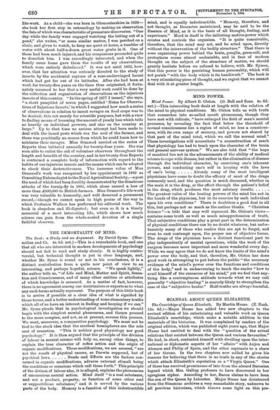life-work. As a child—she was born in Gloucestershire in 1828—
she took her first step in entomology by making an observation the fate of which was characteristic of premature discoveries. "One day while the family were engaged watching the letting out of a pond," she writes, "or some similar matter, I was perched on a chair, and given to watch, to keep me quiet at home, a tumbler of water with about half-a-dozen great water grubs in it. One of them had been much injured, and his companions proceeded quite to demolish him. I was exceedingly interested, and when the family came home gave them the results of my observations, which were entirely disbelieved." It was not until 1852, how- ever, that her attention was seriously directed to the study of insects by the accidental capture of a rose-underwinged locust which had got far out of its latitudes. After she had been at work for twenty-five years on the lines thus originated, it fortu- nately occurred to her that a very useful work could be done by the collection and organisation of observations on the injurious insects of this country. "In the spring of 1877 I issued," she says, "a short pamphlet of seven pages, entitled Notes for Observa- tions of Injurious Insects,' in which I suggested how much a series of observations in relation to insect ravages on food crops was to be desired; this not merely for scientific purposes, but with a view to finding means of lessening the amount of yearly loss which tells so heavily on individual growers, and also on the country at large." Up to that time no serious attempt had been made to deal with the insect pests which vex the soul of the farmer, and there was practically no source from which he could learn how to minimise their ravages. Miss Ormerod carried on the series of Reports thus initiated annually for twenty-four years. She was soon able to enlist the aid of volunteer observers throughout the length and breadth of the country, and in her twenty-four Reports is contained a complete body of information with regard to the habits of our injurious insects and the means which can be adopted to check their destructiveness. The immense value of Miss Ormerod's work was recognised by her appointment in 1882 as Consulting Entomologist to the Royal Agricultural Society,—a post the need of which had been forcibly demonstrated by the disastrous attacks of the turnip-fly in 1881, which alone caused a loss of more than £500,000 to British farmers. Miss Ormerod's life-work was very valuable to humanity, and well deserved a permanent record,—though we cannot speak in high praise of the way in which Professor Wallace has performed his editorial work. The book is shapeless and ill-digested; but even so it is a timely memorial of a most interesting life, which shows how much science can gain from the whole-souled devotion of a single faithful observer.



























































 Previous page
Previous page